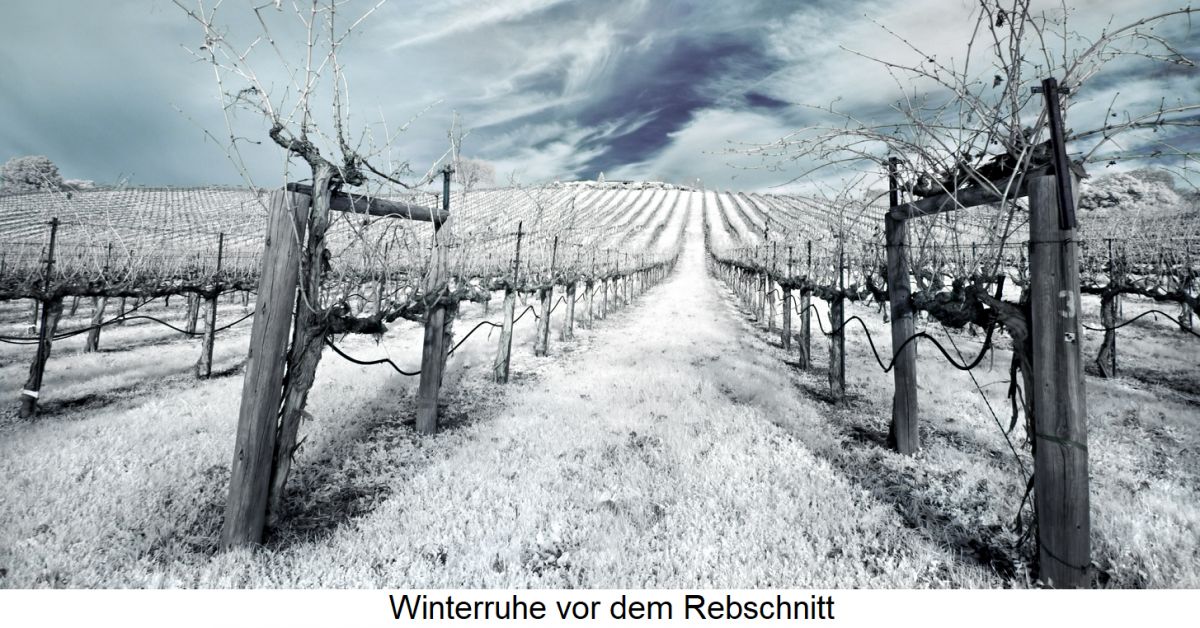The vegetation period (also vegetation phase or period) is the rhythmically repeating part of the year in which a plant actively grows and develops. The study of the associated biological processes is called phenology. In viticulture, the growing season is the period from the last frost (late frost) in spring to the first frost (early frost) in autumn. This should be at least 180 days. The remaining part of the year during which a perennial plant does not grow is referred to as the vegetation dormancy, rest period or dormant season. The totality of the annually recurring growth phases of a plant including the dormant period is the vegetation cycle. In viticulture, however, the vegetative cycle of the vine is often understood as a period without a dormant period.
Phases of the cycle
The months or periods listed in the table below for the individual cycles of the vine are average values; the range of variation can be relatively large. Possible influencing factors are environmental conditions such as climate (microclimate), weather, as well as soil composition and environmental conditions such as vine enemies. The period or pace of development is also strongly dependent on the grape variety. Very early ripening varieties go through the cycle from budding to maturation (ripeness) very quickly in around 130 days and are therefore suitable for cooler wine-growing regions. Late-ripening varieties such as Riesling and Grüner Veltliner need more light and warmth, they have a long growth cycle of up to 200 days (see also under ripening time). Last but not least, the work of the winegrower in the vineyard also has an effect.

The annual cycle of the vine begins after pruning in winter with bud burst in spring and ends with leaf fall in late autumn. A multitude of complex biochemical processes take place in the organs of the vine. The grape harvest should take place at the most optimal stage of ripeness of the grapes. This ideal state with a balanced sugar/acid ratio in the berries is also called physiological ripeness. The period from flowering to harvesting is estimated at around 100 days, although this depends greatly on the grape variety and other factors.
Phase |
Duration/time |
Northern hemisphere |
Southern hemisphere |
| Budding | - | March - April | September - October |
| Flowering | 8 days | May - June | November - December |
| Fruit set | - | June - July | December - January |
| Véraison (onset of ripening) | - | August | February |
| Maturation (maturity) physiological maturity |
- | August - October | February - April |
| Engustment | End of maturation | - | - |
| Leaf fall | - | November - December | May - June |
| Winter rest | 3 months | December - February | June - August |

An ideal vegetation cycle in Germany and Austria as well as other European countries (wine-growing zones A and B) is as follows: After flowering as early as possible, the grapes should be exposed to moderate warmth and sufficient moisture from fruit set onwards. A hillside location with at best vertical exposure (sunlight) and the proximity of bodies of water (seas, lakes, rivers) have a very positive effect. From the Véraison onwards, sunny, warm but not too hot weather is advantageous. A long, warm but not too dry autumn promotes sugar storage during the day and cool nights promote acidity. It should not rain before and during the grape harvest.
Cycle in pictures
A very clear video (click to watch) about the annual vegetation cycle of the vine with all its stages can be seen on YouTube using the example of Moselle pole training (single-pole training). The nine pictures show the entire process from winter to autumn (1 to 7: © Weinhof / Gästehaus Edgar Hermes).



BBCH code
With regard to the optimal or recommended time of application of fertiliser and plant protection measures, the so-called BBCH code has been developed. The BBCH scale corresponds to the vegetation cycle of a plant. The climatic changes that have been noticeable worldwide since the 1980s will also have a very strong impact on the vegetation cycle and viticulture. These are explained under the heading Climate Change.
Further information
The criteria for the suitability of a region for viticulture are called viticultural suitability. A list of relevant keywords on the subject of grapevine can be found under Grapevine, a complete list of all work and procedures in the vineyard within the vegetation cycle can be found under Vineyard Care, and a list of the various procedures relating to ecological cultivation can be found under Organic (Ecological) Vit iculture.
Pictures 1 to 7: © Weinhof / Gästehaus Edgar Hermes
Voices of our members

Using the encyclopaedia is not only time-saving, but also extremely convenient. What's more, the information is always up to date.
Markus J. Eser
Weinakademiker und Herausgeber „Der Weinkalender“